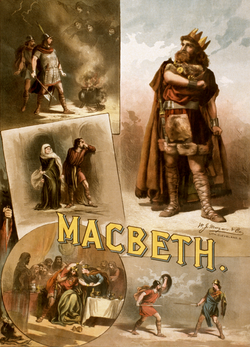Hey all, today is day 3 of Pagan Culture's 4th Bloganiversary Party.
For today Magaly selected the theme
Poetry
Normally I would fall back on my beloved Poe, but all of his Witch related pieces are short story's not poems. So that leaves me with Shakespeare (oh darn...wink, wink)
Song of the Witches
Double, double toil and
trouble;
Fire burn and caldron bubble.
Fillet of a fenny snake,
In the caldron boil and bake;
Eye of newt and toe of frog,
Wool of bat and tongue of dog,
Adder's fork and blind-worm's
sting,
Lizard's leg and howlet's
wing,
For a charm of powerful
trouble,
Like a hell-broth boil and
bubble.
Double, double toil and
trouble;
Fire burn and caldron bubble.
Cool it with a baboon's blood,
Then the charm is firm and
good.
 |
| A poster for a c. 1884 American production of Macbeth |
Shakespeare uses bits of this poem in his play Macbeth (written between 1603-1607),
one of my favorites.
Macbeth Act 4, scene
1, 10–11, etc.
Three Scottish witches are going about their business—tossing poisoned
entrails, eye of newt, toe of frog, and such, into a cauldron—while awaiting a
visit from the man they said would be king: Macbeth. "Double, double toil and
trouble" is part of the refrain to their demonic incantation, an inspiring
little number in tetrameter (four accents per line). The collective memory has
clouded somewhat; often, this refrain comes to mind in the jumbled form "Bubble,
bubble, toil and trouble," which makes even less sense than the original. The
witches are actually trying, with their spells, to pile up toil and trouble
until they "double"—yielding twice the toil and double the trouble for Macbeth,
presumably.
Even though I searched and searched I couldn't find out which came first, Macbeth or Song of Witches. Either way I believe this piece has been very significant is shaping the negative aspects associated with witches.
Make sure to stop by Pagan Culture her sponsor today is Gothic Miniatures, talk about some small scale works of art!
 |
| A traditional playing of the witches from a 1983 production |
Make sure to stop by Pagan Culture her sponsor today is Gothic Miniatures, talk about some small scale works of art!



4 comments:
You are so right, these three ladies are at the top of the ugly and evil fictional witches parade, but if we continue sharing the positive images of modern and ancient witches, eventually there will be balance. And a whole lot of fun!
P.S. Poe fits everywhere. He's writing is too yummy not to ;-)
Hi C,
I looked up Shakespeare's witches sonnet not to long ago.
I had found the witches herbal code and wanted to find out just exactly what the witches were putting into their cauldron.
Turns out to be some leaves,moss, roots and wild flowers.
I guess Shakespeare didn't think saying roots of this and leaves of that sounded very sinister or rhymed as well.
Great post.
Old Billy Shakespeare just couldn't leave the real stuff as it was....he had to spice up the brew if you will. The witches in this play have most certainly had a negative image stamp on most peoples minds when it comes to witches. But then in his own way so did Walt Disney. Be that as it may, I love me wickedy witches in fiction and you have brought the bad of the bad to light today. Oma Linda
I see the three witches from the opposite side of the fire.
Back in my college days, I wrote a term paper on the occult/arcane secrets hidden (some not so well as others) in Shakespeare's works. My thesis was that the three witches weren't hags in the modern sense of the word but Hags -- the forces of Nature personified like the Cailleach Bheara. Their presence sets the atmosphere of the play and the events to unfold, but it is the reactions of the players that tilt their prophecies into the realm of evil.
Post a Comment